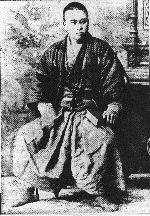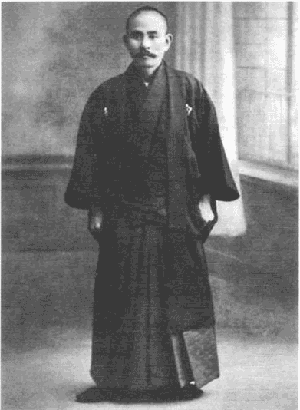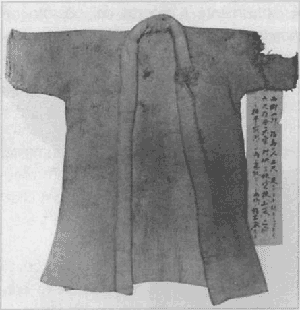by Neil Ohlenkamp
Shiro Saigo is best known for his participation in the 1886 Tokyo Metropolitan Police Judo vs jujutsu tournament held to determine which martial art was superior in a true fight. It was sanctioned by Mr. Mishima, Chief of Police of Tokyo. Jigoro Kano put 15 of his best students, including Shiro Saigo, against Totsuka-ha Yoshin-ryu jujutsu masters. The Totsuka team included four or five jujutsu masters from other schools, but all eyes were on the ten or so matches between Totsuka and Kodokan. Jigoro Kano wrote the following regarding his opponents: "Totsuka Hikosuke was considered the strongest jujutsuka of the Bakumatsu Period (end of the shogunate). After Hikosuke, (his son) Eimi carried the name of the school, and he trained many outstanding jujutsuka. . . In truth, Totsuka's side had powerful fighters and were no blowhards. . . When you mentioned the name Totsuka, you meant the greatest jujutsu masters of that era. My own Tenshin Shinyo-ryu and Kito-ryu (jujutsu) teachers were sorely pressed when they went up against Totsuka jujutsu masters at the shogunate's Komusho dojo. . ."
This match firmly established Judo as superior to jujutsu, and Judo was subsequently adopted as the official training style for the Tokyo police academy. This led to widespread acceptance of Judo as the most effective form of hand-to-hand combat in Japan, and it became recognized that Jigoro Kano had created training methods that were superior to those traditionally used in jujutsu. Exceptionally talented as a martial artist, he was particularly well known for his powerful yama arashi ("mountain storm") technique. He earned the rank of shodan in Judo in August 1883, nidan in September of the same year, jumped to yodan in August 1885, and godan in January 1889. However, he later left the Kodokan organization in May 1890 while Jigoro Kano was away travelling.
Shiro Saigo was born on Feb 4, 1866 in Aizu Wakamatsu. He was the third son of Shida Sadajiro, a samurai of the Aizu Domain. In 1882 he moved to Tokyo and enrolled in the Kodokan. According to the Kodokan, in 1884 he was adopted into the family of Tanomo Saigo, a former elder councillor of the Aizu Domain and took the name Hoshina Shiro. In 1888 he reverted to the surname Saigo in order to resurrect the Saigo family line, which had died out with the passing of Tanomo Saigo. Shiro Saigo died in Onomichi in Hiroshima prefecture in December 1922. |
|

 One of the Four Heavenly Lords (Shitenno) of Kodokan Judo, the fundamental pillars in the creation of Judo, Shiro Saigo was one of the first students of Jigoro Kano. In 1883 Jigoro Kano divided his students into two groups creating yudansha, or graded students, and mudansha, or ungraded students. Shiro Saigo, along with Tsunehiro Tomita, were the first to be awarded the yudansha grade, a grade which a few years later became recognized by the black belt. Saigo and Tomita were the first black belts recorded in the history of Judo (and all martial arts since Jigoro Kano created this system of ranks).
One of the Four Heavenly Lords (Shitenno) of Kodokan Judo, the fundamental pillars in the creation of Judo, Shiro Saigo was one of the first students of Jigoro Kano. In 1883 Jigoro Kano divided his students into two groups creating yudansha, or graded students, and mudansha, or ungraded students. Shiro Saigo, along with Tsunehiro Tomita, were the first to be awarded the yudansha grade, a grade which a few years later became recognized by the black belt. Saigo and Tomita were the first black belts recorded in the history of Judo (and all martial arts since Jigoro Kano created this system of ranks). The Kodokan won all the matches but one or two that ended in a draw. The final match was between Saigo and a much larger and more experienced jujutsu master who later became head of Yoshin-ryu jujutsu. It was a match that pitted two very different styles against each other. Saigo lagged the initial 10 minutes of the battle suffering relentless attacks. Frequently Saigo was seemingly overpowered and was thrown up in the air, but he always came down on his feet in a controlled manner. People compared Saigo's movements to that of an agile cat. After 10 minutes Saigo counterattacked, but couldn't end the match. About 15 minutes into the fight Saigo perfectly executed his trademark Yama Arashi, which ended the match with such force that his opponent retired with a concussion.
The Kodokan won all the matches but one or two that ended in a draw. The final match was between Saigo and a much larger and more experienced jujutsu master who later became head of Yoshin-ryu jujutsu. It was a match that pitted two very different styles against each other. Saigo lagged the initial 10 minutes of the battle suffering relentless attacks. Frequently Saigo was seemingly overpowered and was thrown up in the air, but he always came down on his feet in a controlled manner. People compared Saigo's movements to that of an agile cat. After 10 minutes Saigo counterattacked, but couldn't end the match. About 15 minutes into the fight Saigo perfectly executed his trademark Yama Arashi, which ended the match with such force that his opponent retired with a concussion. Shiro Saigo became an idol in Japan and was the model for the main character in Tomita Tsuneo's 1942 novel Sugata Sanshiro, which later became a popular movie in 1943. Sometimes called "Judo Saga", Akira Kurosawa's extraordinary first feature concerns the genesis of Judo. Akira Kurosawa (Seven Samurai, Ikiru), perhaps the best known of all Japanese directors, shot this film during World War II and wartime censors ordered many cuts, but it successfully chronicles the struggle to establish Judo as Japan's premiere martial art.
Shiro Saigo became an idol in Japan and was the model for the main character in Tomita Tsuneo's 1942 novel Sugata Sanshiro, which later became a popular movie in 1943. Sometimes called "Judo Saga", Akira Kurosawa's extraordinary first feature concerns the genesis of Judo. Akira Kurosawa (Seven Samurai, Ikiru), perhaps the best known of all Japanese directors, shot this film during World War II and wartime censors ordered many cuts, but it successfully chronicles the struggle to establish Judo as Japan's premiere martial art.